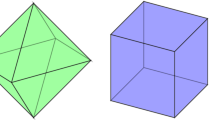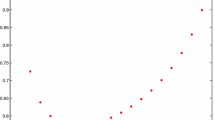Abstract
Consider a collection of particles interacting through an attractive-repulsive potential given as a difference of power laws and normalized so that its unique minimum occurs at unit separation. For a range of exponents corresponding to mild repulsion and strong attraction, we show that the minimum energy configuration is uniquely attained—apart from translations and rotations—by equidistributing the particles over the vertices of a regular top-dimensional simplex (i.e. an equilateral triangle in two dimensions and regular tetrahedron in three). If the attraction is not assumed to be strong, we show that these configurations are at least local energy minimizers in the relevant \(d_\infty \) metric from optimal transportation, as are all of the other uncountably many unbalanced configurations with the same support. We infer the existence of phase transitions. The proof is based in part on a simple isodiametric variance bound which characterizes regular simplices; it shows that among probability measures on \({{\mathbf {R}}}^n\) whose supports have at most unit diameter, the variance around the mean is maximized precisely by those measures which assign mass \(1/(n+1)\) to each vertex of a (unit-diameter) regular simplex.


Similar content being viewed by others
Change history
01 June 2021
A Correction to this paper has been published: https://doi.org/10.1007/s00205-021-01663-2
References
Albi , G., Balagué , D., Carrillo , J.A., von Brecht , J.: Stability analysis of flock and mill rings for second order models in swarming. SIAM J. Appl. Math. 74, 794–818, 2014
Balagué , D., Carrillo , J.A., Laurent , T., Raoul , G.: Dimensionality of local minimizers of the interaction energy. Arch. Ration. Mech. Anal. 209, 1055–1088, 2013
Bertozzi, A.L., Kolokolnikov, T., Sun, H., Uminsky, D., von Brecht, J.: Ring patterns and their bifurcations in a nonlocal model of biological swarms. Commun. Math. Sci. 13, 955–985, 2015
Blanchet, A., Carlier, G.: From Nash to Cournot–Nash equilibria via the Monge–Kantorovich problem. Philos. Trans. R. Soc. Lond. Ser. A Math. Phys. Eng. Sci. 372, 20130398, 2014
Borwein , J.M., Zhu , Q.J.: Variational methods in the presence of symmetry. Adv. Nonlinear Anal. 2, 271–307, 2013
Braides, A.: \(\Gamma \)-convergence for beginners. In: Oxford Lecture Series in Mathematics and Its Applications, vol. 22. Oxford University Press, Oxford (2002)
Burchard, A., Choksi, R., Hess-Childs, E.: On the strong attraction limit for a class of nonlocal interaction energies. Nonlinear Anal. 198, 111844, 2020. https://doi.org/10.1016/j.na.2020.111844
Burchard, A., Choksi, R., Topaloglu, I.: Nonlocal shape optimization via interactions of attractive and repulsive potentials. Indiana Univ. Math. J. 67, 375–395, 2018
Carrillo, J.A., Figalli, A., Patacchini, F.S.: Geometry of minimizers for the interaction energy with mildly repulsive potentials. Ann. Inst. H. Poincaré Anal. Non Linéaire 34, 1299–1308, 2017
Carrillo , J.A., Hittmeir , S., Volzone , B., Yao , Y.: Nonlinear aggregation-diffusion equations: radial symmetry and long time asymptotics. Invent. Math. 218(3), 889–977, 2019
Carrillo, J.A., Huang, Y.: Explicit equilibrium solutions for the aggregation equation with power-law potentials. Kinet. Relat. Models 10, 171–192, 2017
Carrillo, J.A., Choi, Y.-P., Hauray, M.: The derivation of swarming models: mean-field limit and Wasserstein distances. In: Collective Dynamics from Bacteria to Crowds. CISM Courses and Lecture, vol. 553, pp. 1–46. Springer, Vienna (2014)
Carrillo, J.A., McCann, R.J., Villani, C.: Kinetic equilibration rates for granular media and related equations: entropy dissipation and mass transportation estimates. Rev. Mat. Iberoam. 19, 1–48, 2003
Choksi, R., Fetecau, R.C., Topaloglu, I.: On minimizers of interaction functionals with competing attractive and repulsive potentials. Ann. Inst. H. Poincaré Anal. Non Linéaire 32, 1283–1305, 2015
Craig , K., Bertozzi , A.L.: A blob method for the aggregation equation. Math. Comput. 85, 1681–1717, 2016
Danzer, L., Grünbaum, B., Klee, V.: Helly’s theorem and its relatives. In: Proceedings of the Symposia in Pure Mathematics, vol. VII, pp. 101–180. American Mathematical Society, Providence (1963)
Delgadino, M.G., Yan, X., Yao, Y.: Uniqueness and nonuniqueness of steady states of aggregation-diffusion equations. Commun. Pure Appl. Math. 2020. https://doi.org/10.1002/cpa.21950
Fellner, K., Raoul, G.: Stable stationary states of non-local interaction equations. Math. Models Methods Appl. Sci. 20, 2267–2291, 2010
Fetecau , R.C., Huang , Y.: Equilibria of biological aggregations with nonlocal repulsive–attractive interactions. Physica D 260, 49–64, 2013
Fetecau , R.C., Huang , Y., Kolokolnikov , T.: Swarm dynamics and equilibria for a nonlocal aggregation model. Nonlinearity 24, 2681–2716, 2011
Frank , R.L., Lieb , E.H.: A “liquid–solid” phase transition in a simple model for swarming, based on the “no flat-spots” theorem for subharmonic functions. Indiana Univ. Math. J. 67, 1547–1569, 2018
Frank, R.L., Lieb, E.H.: Proof of spherical flocking based on quantitative rearrangement inequalities. To appear in Ann. Sc. Norm. Super. Pisa Cl. Sci. (5). Also arXiv:1909.04595
Holm, D.D., Putkaradze, V.: Formation of clumps and patches in self-aggregation of finite-size particles. Physica D 220, 183–196, 2006
Jung , H.: Über die kleinste Kugel, die eine räumliche Figur einschliesst. J. Reine Angew. Math. 123, 241–257, 1901
Kang, K., Kim, H.K., Lim, T., Seo, G.: Uniqueness and characterization of local minimizers for the interaction energy with mildly repulsive potentials. Calc. Var. Partial Differ. Equ. 60(1), 15, 2021
Kawohl, B.: Rearrangements and convexity of level sets in PDE, vol. 1150. In: Lecture Notes in Mathematics. Springer, Berlin (1985)
Kolokolnikov, T., Sun, H., Uminsky, D., Bertozzi, A.: Stability of ring patterns arising from two-dimensional particle interactions. Phys. Rev. E 84(1), 015203, 2011
Lennard-Jones , J.E.: On the determination of molecular fields. Proc. R. Soc. Lond. A 106, 463–477, 1924
Lim, T., McCann, R.J.: Geometrical bounds for the variance and recentered moments. To appear in Math. Oper. Res. Preprint arXiv:2001.11851 based in part on an earlier version of the present manuscript preserved at arXiv:1907.13593v1
Lopes , O.: Uniqueness and radial symmetry of minimizers for a nonlocal variational problem. Commun. Pure Appl. Anal. 18, 2265–2282, 2019
McCann , R.J.: A convexity principle for interacting gases. Adv. Math. 128, 153–179, 1997
McCann , R.J.: Stable rotating binary stars and fluid in a tube. Houst. J. Math. 32, 603–632, 2006
Mogilner, A., Edelstein-Keshet, L.: A non-local model for a swarm. J. Math. Biol. 38, 534–570, 1999
Popoviciu , T.: Sur les équations algébriques ayant toutes leurs racines réelles. Mathematica (Cluj) 9, 129–145, 1935
Topaz , C.M., Bertozzi , A.L., Lewis , M.A.: A nonlocal continuum model for biological aggregation. Bull. Math. Biol. 68, 1601–1623, 2006
Sun, H., Uminsky, D., Bertozzi, A.L.: Stability and clustering of self-similar solutions of aggregation equations. J. Math. Phys. 53, 115610, 2012
Tkocz, T.: Personal communication
Toscani, G.: One-dimensional kinetic models of granular flows. M2AN Math. Model. Numer. Anal. 34, 1277–1291, 2000
Villani, C.: Topics in optimal transportation. In: Graduate Studies in Mathematics, vol. 58. American Mathematical Society, Providence (2003)
von Brecht, J.H., Uminsky, D., Kolokolnikov, T., Bertozzi, A.L.: Predicting pattern formation in particle interactions. Math. Models Methods Appl. Sci. 22(1140002), 31, 2012
Author information
Authors and Affiliations
Corresponding author
Additional information
Communicated by D. Kinderlehrer.
Publisher's Note
Springer Nature remains neutral with regard to jurisdictional claims in published maps and institutional affiliations.
TL is grateful for the support of ShanghaiTech University, and in addition, to the University of Toronto and its Fields Institute for the Mathematical Sciences, where parts of this work were performed. RM acknowledges partial support of his research by the Canada Research Chairs Program and Natural Sciences and Engineering Research Council of Canada Grants 217006-15 and -20. The authors are grateful to Andrea Bertozzi, Almut Burchard, Tomasz Tkocz and an anonymous seminar participant at Seoul National University for stimulating interactions, and to Hyejung Choi for drawing the figures.
“The original online version of this article was revised: ” The original version of this article unfortunately contained a typesetting mistake in the references. In references 9 and 14 the correct journal name entry “Ann. Inst. H. Poincaré Anal. Non Linéaire" has been changed to “Cell” by mistake.
Isodiametry, Variance, and Regular Simplices
Isodiametry, Variance, and Regular Simplices
Our variational characterization of the unit simplex, Theorem 2.1, was discovered using convex analysis and duality in [29]. However, it turns out to be closely related to a classical result of Jung [24], for which a modern proof can be found in Danzer, Grünbaum and Klee [16].
Theorem A.1
(Jung) Let \(K \subseteq {{\mathbf {R}}}^n\) be compact with \({{\,\mathrm{diam}\,}}(K)=1\). Then K is contained in a closed ball of radius \(r_n=\sqrt{\frac{n}{2n+2}}\). Moreover, K contains the vertices of a unit n-simplex unless it lies in some smaller ball.
In our companion work we showed that our characterization implies Jung’s theorem [29]. In this appendix we show instead that our characterization follows from Jung’s theorem, so that the two results are in some sense equivalent. We are grateful to an anonymous seminar participant for drawing our attention to Jung’s work, and to Tomasz Tkocz [37] who subsequently observed independently from us that our characterization could be inferred using Jung’s theorem. Let us begin with an elementary geometric result based on Lemma 3.4, which concerns higher dimensional generalizations \(\Omega \subseteq {{\mathbf {R}}}^n\) of Reuleaux’s triangle and tetrahedron.
Lemma A.2
(On Reuleaux simplices) If \(\Delta \subseteq {{\mathbf {R}}}^n\) is the set of vertices of a unit n-simplex centered at \(z \in {{\mathbf {R}}}^n\) and \(\Omega {:}{=} \cap _{x \in \Delta } \overline{B_1(x)}\), then \(\Delta = \Omega \cap {\partial }B_{r_n}(z)\) where \(B_r(x)\) denotes the ball of radius r centered at x.
Proof
Let \(\Delta = \{x_0,\ldots ,x_n\} \subseteq {{\mathbf {R}}}^n\) be the vertices of a unit n-simplex centered at \(z = \frac{1}{n+1}\sum x_i\). Any vectors \(y_0,\ldots ,y_n\) in a Hilbert space H satisfy
Given an arbitrary point \(x \in \Omega {:}{=} \cap _{x \in \Delta } \overline{B_1(x)}\), taking \(y_i=\frac{1}{n+1}(x-x_i)\) and \(H={{\mathbf {R}}}^n\) the identity above yields
Estimating the right hand side with Lemma 3.4(a) yields \( |x-z|^2 \le r_n^2, \) with equality if and only if \(x \in \Delta \). Thus \(\Omega \subseteq \overline{B_{r_n}(z)}\) and \(\Delta = \Omega \cap {\partial }B_{r_n}(z)\) as desired.
Proof of Theorem 2.1
(using Theorem A.1) The representation (1.10) shows the vertices of a standard n-simplex of diameter \(\sqrt{2}\) lies on a unique sphere of radius \(r_n \sqrt{2}\); thus the vertices of a unit n-simplex lies on a (unique) sphere of radius \(r_n\). Assume \(d=1\) without loss of generality hereafter. Any probability measure \(\mu ^*\) which assigns mass \(1/(n+1)\) to each vertex of a unit n-simplex therefore has the desired variance \(r_n^2\). Conversely, let \(\mu \in {{\mathcal {P}}}({{\mathbf {R}}}^n)\) have support \(K=\mathop \mathrm{spt}\mu \) with \({{\,\mathrm{diam}\,}}[K] \le 1\). Jung’s theorem then asserts K is enclosed by a sphere \(S={\partial }B_{r}(z)\) of radius \(r \le r_n\) centered at some \(z \in {{\mathbf {R}}}^n\), and that \(r<r_n\) unless K contains a unit n-simplex. The familiar computation
shows \({{\,\mathrm{{Var}}\,}}(\mu ) \le r_n^2\). We conclude equidistribution \(\mu ^*\) over the vertices of the unit n-simplex has maximal variance subject to the unit diameter constraint on its support. Also, (A.1) shows \({{\,\mathrm{{Var}}\,}}(\mu )<r_n^2\) unless \({\bar{x}}(\mu )=z\) and \(r=r_n\). Thus \(\mu \) has smaller variance than \(\mu ^*\) unless K contains the vertices of a unit n-simplex \(\Delta {:}{=} \{x_0,\ldots , x_n\} \subseteq K\).
We henceforth assume \({{\,\mathrm{{Var}}\,}}(\mu )=r_n^2\), so \(\Delta \subseteq K = \mathop \mathrm{spt}\mu \) and \({\bar{x}}(\mu )=z\). From \({{\,\mathrm{{Var}}\,}}(\mu )=r_n^2\) and \(\mathop \mathrm{spt}\mu \subseteq \overline{B_{r_n}(z)}\) we conclude the full mass of \(\mu \) lies at distance \(r_n\) from its barycenter \(z={\bar{x}}(\mu )\), i.e. \(K\subseteq S= \partial B_{r_n}(z)\). On the other hand, \({{\,\mathrm{diam}\,}}(K) \le 1\) and \(\Delta \subseteq K\) implies \(K \subseteq \Omega \) where \(\Omega {:}{=} \cap _{i=0}^n \overline{B_1(x_i)}\). Lemma A.2 therefore implies \(K=\mathop \mathrm{spt}\mu \subseteq S \cap \Omega = \Delta \). Now there is a familiar bijection between the convex hull \({{\,\mathrm{conv}\,}}(\Delta )\) and convex combinations of its vertices, c.f. Remark 2.5 [29]. The only convex combination of the vertices of \(\Delta \) having barycenter at z assigns equal weights \(1/(n+1)\) to each vertex. From \({\bar{x}}(\mu )=z=\frac{1}{n+1} \sum _{i=0}^n x_i\) we deduce \(\mu = \frac{1}{n+1} \sum _{i=0}^n \delta _{x_i}\) as desired. \(\quad \square \)
Rights and permissions
About this article
Cite this article
Lim, T., McCann, R.J. Isodiametry, Variance, and Regular Simplices from Particle Interactions. Arch Rational Mech Anal 241, 553–576 (2021). https://doi.org/10.1007/s00205-021-01632-9
Received:
Accepted:
Published:
Issue Date:
DOI: https://doi.org/10.1007/s00205-021-01632-9




